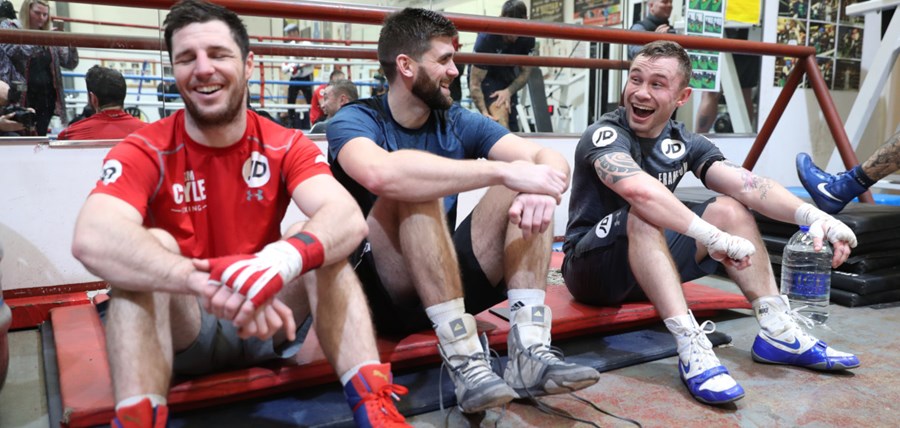Leading boxing nutritionist on how to cut weight safely

Liverpool John Moores University's James Morehen explains how he helps WBA super-middleweight champion Rocky Fielding avoid dangerous weight cutting.
The morning of the fight.
Boxer Rocky Fielding is enjoying a stroll around Offenburg town centre with his family, friends and his performance nutritionist, James Morehen.
In a few hours, the super-middleweight from Liverpool will weigh in for his first world title challenge.
They stop for a coffee, and then Fielding works up a sweat to lose the final few pounds needs to before stepping on the scales.
It turns out that fighters – whether in boxing, MMA or wrestling – can make weight without collapsing, suffering seizures or temporarily losing their sight.
Acute weight loss, the practice of sweating out vast amounts of water to reach the required weight limit, has become common in MMA and boxing.
In the UFC, it’s not unusual for a fighter to lose 20lbs – often more than 10 per cent of their body weight – in the 48 hours leading up their weigh in, only to put it all back on once they’re off the scales.
Fielding is proof there is another, safer way.
With guidance from Morehen and his team at Liverpool’s John Moores University, Fielding - who is in the boxing betting to beat Mexican superstar Canelo Alvarez in December - has changed the way he makes weight.
Rather than shedding dangerous amounts of weight in a few days, he instead focuses on strategically manipulating body composition over the course of a camp.
His decision has paid off. The 31-year-old has successfully made weight in his last 10 fights.
That trip to Germany in July, meanwhile, ended with Fielding beating Tyron Zeuge in the fifth round and winning the WBA super-middleweight world title.
“Before working with LJMU, Rocky used to make weight on his own, without a performance nutritionist,” says Morehen, who has overseen Fielding’s nutritional strategies for the past two years
“That was early in his career. Then he missed weight and realised there must be an easier and healthier way of doing this than sitting in the sauna and sweating. That’s where our journey began.
“Ever since Rocky's worked closely with the university we’ve really nailed down some of the fundamental basics of sport science testing, to understand him as an individual athlete and the safe margins and safe changes we can make.”
The first part of making weight actually begins before training camp.
Coming into a six to eight-week camp massively overweight makes it much more difficult for any fighter to cut down to the limit while remaining strong and powerful, so the responsibility is on the fighter to remain in relatively good shape even when a fight isn’t yet scheduled.
Morehen’s role begins at the start of camp, where he will baseline Fielding’s body composition using a dual-energy x-ray absorptiometry (DXA) machine.
As well as Fielding’s total body mass, a series of baseline tests reveal how much of his body is made up of other tissues, in particular skeletal muscle mass and fat mass.
The first part of camp is dedicated not so much to making weight, but to manipulating body composition by reducing fat mass while preserving or gaining muscle mass.
“When a boxer is going into a camp, there's different sections of that camp, just like the sections of a football season,” Morehen says.
“There's the pre-season period, the mid-season, and then you're trying to finish strong.
“In that first period of the camp you don't want to think about what they're doing in the final week on the scale.
“What you're trying to do in the first stage and leading into the middle is to reduce fat mass and increase strength, power and fitness.”

Morehen works with Fuel Station, a nutritional company, to tailor meals to Fielding’s diet in the lead up to the fight, and collaborates with strength and conditioning coach Elliot Hall and trainer Jamie Moore to build strategic nutritional plans around his training and overall energy expenditure.
Heavy sparring days require more carbohydrates, so that Fielding has the energy he needs to train hard.
It’s not until the final 10 days or so of camp, when Fielding has sparred for the last time before the fight, that the focus switches to cutting weight.
GB Boxing advises that fighters should lose no more than two per cent of their body weight through dehydration, which, for super-middleweights like Fielding, is about 3lbs.
That’s a similar amount to what a football or rugby player would lose in a single match.
Morehen’s strategy of reaching the final phase of camp with Fielding carrying the lowest amount of fat possible ensures that there is no need for the kind of acute weight cut that puts fighters in real danger.
The Liverpudlian didn’t sit in a sauna even once ahead of his world title fight.
“We've got it to a point with Rocky where the acute weight loss only happens on the morning of the weigh in, or maybe the night before,” Morehen says.
“Unfortunately we see some of these boxers do it three or four days out where they are dropping a lot of weight.
“The body is made up of approximately 65% intracellular and 35% extracellular water, and you don't want to mess around with that too much.
“There's a reason there's that much water in the body. It's a major chemical component that keeps us fit and healthy. That's what we always try to get across with the fighters we work with at LJMU.”
Morehen argues that dropping down in weight so dramatically, to the point where some fighters struggle to even stand on the scales, negates the potential advantage of coming into the fight slightly heavier than their opponent.
The benefits of eating and sleeping well during a comfortable weight cut arguably outweigh any gain from acute weight loss.
So why, then, do fighters continue to put their own lives in danger?
“My gut feeling on this is that it's a lack of education,” Morehen says. “People don't realise that the body is a fantastic machine, and we can manipulate certain things in it healthily and safely.
“It's when people don't understand how to do that that they go to extreme lengths.
“We’ve all seen videos of fighters crawling out of saunas. The body isn't meant to go through stuff like that.”
New regulations in the field of sports nutrition are now helping fighters get better guidance.
The Sport and Exercise Nutrition Register (SENr) registers qualified dieticians and nutritionists, providing a source of reliable professionals who use evidence informed practice for athletes.
“It's alarming that we've still got people out there – big names – that are still doing it the wrong way,” Morehen says. “But the register is growing and growing every year.
“People realise that if you can get access to a registered performance nutritionist who has got a degree, who understands and has studied sport science and nutrition for four, five or six years, then you don't have to do the scary weight-making tactics any more.”
The sports nutrition department at Liverpool John Moores University work closely with professional athletes who require assistance to look after their health, make weight safely and perform to the best of their ability.
For more information visit @LJMUNutrition or @James_Morehen on Twitter.





































